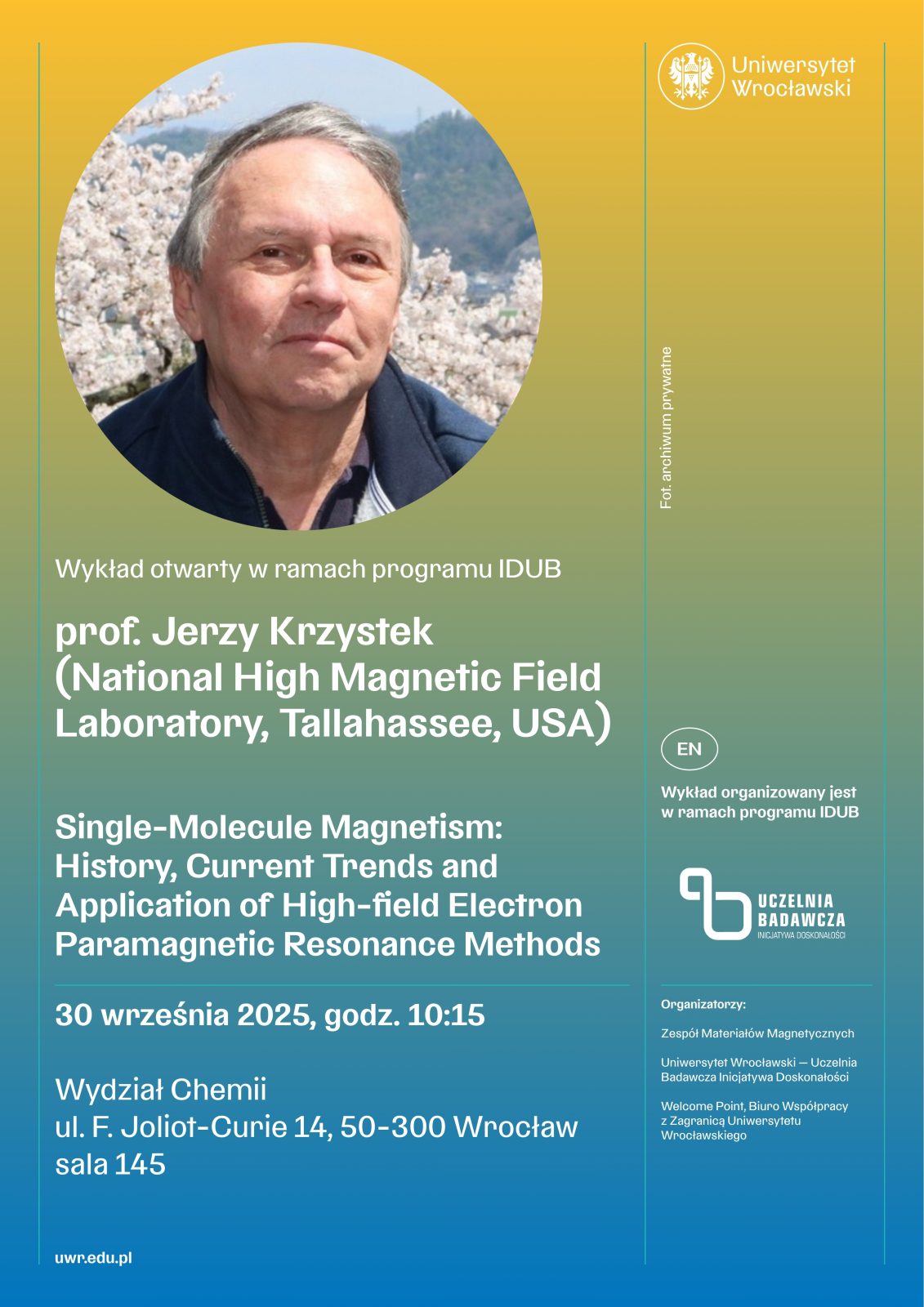
Lecture by prof. Jerzy Krzystek at the Faculty of Chemistry
The Magnetic Materials Research Group (Head: prof. Alina Bieńko) at the Faculty of Chemistry of the University of Wrocław, is pleased to invite you to a lecture by prof. Jerzy Krzystek (USA) entitled Single-Molecule Magnetism: History, Current Trends and Application of High-field Electron Paramagnetic Resonance Methods (Polish title: Magnetyzm jednocząsteczkowy: historia, obecne kierunki i zastosowanie metod elektronowego rezonansu paramagnetycznego w silnych polach). The lecture will take place on 30 September 2025 at 10:15 at the Faculty of Chemistry, ul. F. Joliot-Curie 14. The event is organised within the framework of the Visiting Professors – IDUB UWr programme.
Bio
Dr Jerzy Krzystek (Research Faculty III at MagLab – the equivalent of a full professor) is an internationally recognised expert in molecular spectroscopy, with particular expertise in highly specialised research involving high-field/high-frequency electron paramagnetic resonance spectroscopy (HFEPR) and far-infrared magnetic spectroscopy (FIRMS). His research has broad applications not only in chemistry but also in physics, biology and biotechnology. Since 1995 he has been working at the National High Magnetic Field Laboratory (Tallahassee, USA), where he serves as Deputy Director of the international EMR programme. Prof. Krzystek’s scientific standing is reflected in his high Hirsch index (42), impressive citation count (5522), co-authorship of several books and 149 scientific papers (according to the Scopus database), published in leading high-impact journals such as JACS, Angew. Chem. Int. Ed., Chem. Sci. and Nature Communications. Prof. Krzystek has extensive international experience as a visiting scientist, including at the University of Valencia (Spain, 2008), the Chemistry Research Promotion Center (Taiwan, 2011), Helmholtz-Zentrum Dresden-Rossendorf (Germany, 2015), and the University of Warsaw (2019). He also previously held research positions at the University of Washington (1989–1994) and the Universität Stuttgart (1983–1985). He is the recipient of numerous prestigious awards and distinctions, among them those of the A. E. Haereus Foundation, the Scientific Secretary of the Polish Academy of Sciences, the Max Planck Society, the Ernst and Berta Grimmke Stiftung, and the Belfer Fellowship (Albert Einstein College of Medicine). He has also led several research projects funded by NSF Chemistry, NHMFL IHRP, NSF Award No. CHE-0079649 and FSURF.
About the lecture
This year marks the 33rd anniversary of the seminal communication by Caneschi et al. on the magnetism of the famous Mn12Ac cluster [1]. It spurred a generation of research on the properties of so-called single-molecule magnets (SMMs). This, in turn, gave an immense boost to several areas of research and technical development, among them coordination chemistry, and magnetic resonance. Coordination chemistry excelled in designing ligands coordinating to transition metal ions, thus modulating the magnetic properties of the resulting clusters. Magnetic resonance, and specifically high-frequency and -field electron paramagnetic resonance (HFEPR) in turn spectacularly succeeded in investigating the intimate interactions within the clusters, since the primary phenomenon responsible for their magnetic properties, zero-field splitting (ZFS) falls fortuitously almost exactly in the sub-terahertz wave frequency range and magnetic fields used in that technique [2]. In my presentation I will review the history and development of single-molecule magnetism from clusters to single ions and from transition metals to lanthanides and actinides. I will also discuss the current status of the field, as well as its projected future including potential applications. Given my background, I will heavily concentrate on the application of HFEPR in this area.
[1] A.Caneschi, D. Gatteschi, R. Sessoli, J. Am. Chem. Soc., 1991, 113, 5874-5876.
[2] A.-L. Barra, D. Gatteschi, R. Sessoli, Phys. Rev. B, 1997, 56, 8192-8198.

Date of publication: 17.09.2025
Added by: M.K.



